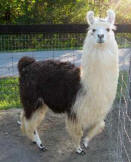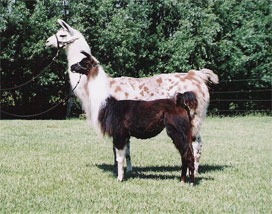Miniature Llamas
 The miniature, or “minillama”, is the same species as the standard llama but very small in size, making them easier to handle and easily owned by a wider section of people. Many people are already referring to them as the “backyard llama”! They are the cutest animals ever.
The miniature, or “minillama”, is the same species as the standard llama but very small in size, making them easier to handle and easily owned by a wider section of people. Many people are already referring to them as the “backyard llama”! They are the cutest animals ever.
You won’t go broke feeding thes guys and they can be kept in a much smaller area than a stancard llama, including your back yard. The smaller the better, with excellent pedigrees, conformation, and gait.
The Llama is a member of the Camelid family. They are closely related to the camel as well as to the alpaca. Most of the Llamas in this country arrived here from South American countries. Llamas come in all shapes, sizes, and colors. The thickness of their wool also varies from light to medium to heavy. The climate where you live and your use for the animal would decide which is better for you. All of the Llamas raised here at Valley Stable are registered with the International Llama Registry and the American Miniature Llama Association.
 This photo is quite an eye opener. A standard llama of the same mature age and sex compared to a mini! Come with us and “GET SMALL” fuzzy, friendly, and easy to handle. All of our Miniature Llamas are registered with the International Llama Registry (ILR) and the American Miniature Llama Association (AMLA).
This photo is quite an eye opener. A standard llama of the same mature age and sex compared to a mini! Come with us and “GET SMALL” fuzzy, friendly, and easy to handle. All of our Miniature Llamas are registered with the International Llama Registry (ILR) and the American Miniature Llama Association (AMLA).
Another use for the Llama includes shearing the wool yearly and selling it to spinners to make yarn eventually woven, knitted, or crocheted into anything from blankets to sweaters or lovely soft gifts for newborns. Soft, lightweight, and hypoallergenic, llama fiber is FABULOUS!
Use as pack animals for hikers is also popular. The Llama has pads, very similar to dogs on its feet, which actually makes them allowed in certain national and state parks where a horse is not allowed, supposedly because of the damage the horse’s hooves can cause to the parks environment. This may seem silly but I don’t make the park regulations and this is a true statement. Traditionally, the Llama has been used as a pack animal in their native countries for thousands of years unlike the Alpaca (which has been kept primarily for their wool only, similar to sheep, therefore historically not as “interactive” with humans as the llama). Throughout history, llamas have also been trained to pull carts and work with humans. For thousands of years, llamas have been close and useful to humans. They still are today and will be tomorrow. The Mini or Miniature llama is HERE TO STAY!
